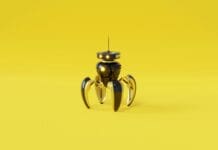This post is also available in:
 עברית (Hebrew)
עברית (Hebrew)
A new 3D-printing method will make it easier to manufacture and control the shape of soft robots, artificial muscles and wearable devices. Researchers at the university of San Diego, California, showed that by controlling the printing temperature of liquid crystal elastomer, or LCE, they can control the material’s degree of stiffness and ability to contract — also known as degree of actuation. What’s more, they are able to change the stiffness of different areas in the same material by exposing it to heat.
Researchers were inspired to create this material with different degrees of actuation by examples in biology and nature. In addition to the combination of muscle and tendon, researchers took cues from the beak of the squid, which is extremely stiff at the tip but much softer and malleable where it is connected to the mouth of the squid.
For example, researchers printed an LCE disk at 40 degrees C (104 F) and heated it up to 90 degrees C (194 F) in hot water. The disk deformed into a conical shape. But an LCE disk composed of areas that are printed at different temperatures (40, then 80 then 120 degrees Celsius, for example), deformed in a completely different shape when heated up.
Finally, as a proof of concept, the team 3D printed an LCE tube that they had tuned during 3D printing and showed that it could adhere to a rigid glass plate much longer when actuated at high temperatures, about 94 C (201 F), than a regular LCE tube with homogenous properties. This could lead to the manufacture of better robotic feet and grippers. The team from the UC San Diego Jacobs School of Engineering detailed their work in Science Advances, as reported by the university’s website.

























